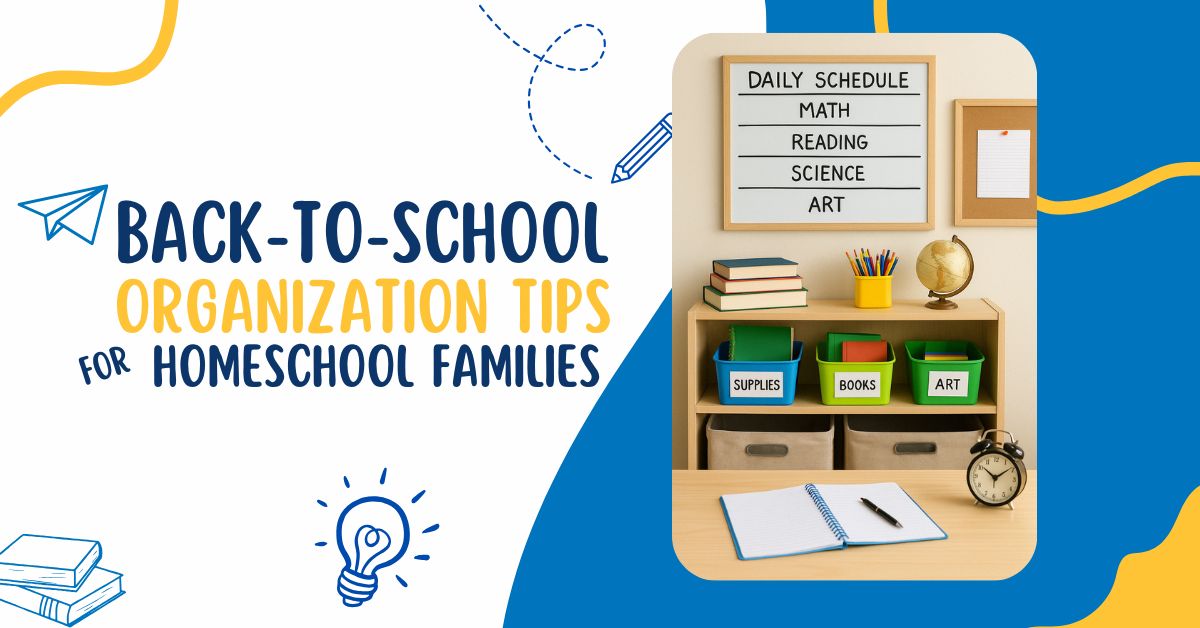The back-to-school season is an exciting time for homeschool families. It’s the perfect moment to reset, plan, and organize so that your homeschooling year begins on the right note. Good organization can help eliminate stress, keep materials accessible, and ensure you’re able to focus on what matters most—teaching and learning together. Below, you’ll find practical homeschool organization tips that will make your upcoming school year more productive and enjoyable.
Start With a Plan
One of the best ways to prepare for a successful homeschool year is to create a clear, flexible plan. Before making any purchases or setting up your space, invest some time in thinking through what your homeschool year will look like.
Start by mapping out your goals for the year. What subjects will you be covering? Are there specific skills or milestones you want your children to achieve? Having these objectives written down gives you direction and helps guide your decision-making related to curricula, resources, and scheduling.
Next, determine a homeschooling schedule that works for your family. Whether you plan to homeschool four mornings a week or use a more relaxed approach, having at least a loose schedule in mind will keep you on track as the year progresses. If possible, involve your children in this planning. Getting input from them can build excitement and help set realistic expectations for everyone.
Create an Organized Learning Space
Once you’ve got a plan, it’s time to think about where your homeschooling will happen. A designated learning space doesn’t need to be large or elaborate, but it does need to be functional and tailored to your kids’ needs. Here are a few tips to create an effective homeschool setup:
- Choose a location with minimal distractions. Whether it’s a corner of the dining room, an extra bedroom, or just a section of the living room, select a space that allows your children to concentrate.
- Invest in comfortable furniture. Make sure your children have supportive chairs and tables at the right height. If space is tight, a folding table and chairs can work.
- Use wall space wisely. Install corkboards or whiteboards for displaying daily assignments, calendars, or educational posters.
- Add storage solutions. Utilize shelving, bins, or bookcases to keep materials off the floor and organized. Labeling bins by category (e.g., “math,” “science,” “art supplies”) makes it easy for everyone to find items and put them back when finished.
While it’s tempting to focus on aesthetics, functionality should always come first. A well-organized homeschool space promotes focus and eliminates the frustration of hunting for lost supplies.
Declutter Before the Year Starts
Before bringing in new materials, take the time to declutter what you already have. Over the years, homeschool supplies and books can pile up, making it harder to stay organized. Decluttering sets a fresh tone for the year and ensures your space isn’t overcrowded with items you no longer use.
Here’s a simple approach to decluttering your homeschool materials:
- Sort into categories. Group materials into categories like books, craft supplies, old curricula, and educational games.
- Decide what to keep. Be honest about what you’ll actually use this year. If something hasn’t been touched in years or doesn’t align with your current plans, it’s probably safe to donate or sell.
- Recycle what you can. Get rid of outdated workbooks, torn papers, or broken supplies that are no longer useful.
Once you’ve cleared out the clutter, you’ll see how much easier it is to organize and find space for the items you truly need.
Stock Up on Essential Supplies
No matter your homeschooling style, having the right supplies on hand is key to staying organized and maintaining productivity. Stocking up at the beginning of the year ensures you aren’t caught off guard when you need something mid-lesson.
Consider creating these categories for your homeschool supplies and restocking as needed:
- Basic supplies: Pencils, pens, markers, erasers, scissors, glue sticks, and paper.
- Organizational tools: Binders, folders, index cards, highlighters, and storage bins.
- Art and craft supplies: Paints, brushes, crayons, construction paper, and clay.
- Educational aids: Flashcards, manipulatives for math, timelines, and maps.
For older children, you might also need a dedicated laptop or tablet for assignments, researching, or online learning programs. Keep a checklist as you shop to avoid duplicate purchases or forgetting essentials.

Use a System for Paperwork
Managing homeschool paperwork is one of the biggest challenges for parents. Between lesson plans, student work, and any records required by your state, it’s easy for papers to pile up. To stay on top of things, create a manageable system that keeps everything organized and easy to access.
- Designate a filing system. Use a filing cabinet, accordion folder, or binders to separate paperwork by subject, student, or school year.
- Digitize when possible. If you prefer less physical clutter, scan important documents so you can store them electronically.
- Break it down weekly. At the end of each week, go through completed assignments and decide what needs to be saved, recycled, or filed away.
Keeping paperwork organized might take extra effort upfront, but it saves time and headaches down the road.
Engage Children in the Process
When kids understand how to organize and maintain their supplies, it empowers them and reduces your workload. Show them where everything belongs and encourage them to return items after each use. Even younger children can take responsibility for tidying up their space, sharpening pencils, or refilling glue sticks.
You might also consider introducing colorful bins or baskets they find appealing, making clean-up feel less like a chore and more like part of their daily routine.
Build Flexibility Into Your Organization
Even with the best-laid plans, homeschooling rarely goes exactly as expected. It’s important to remember that organization doesn’t mean perfection; it means creating systems that work for your family’s unique needs.
For example, if your child tends to get restless during long lessons, keep fidget toys or movement breaks as part of your routine. If you find yourself adjusting your approach to teaching mid-year, give yourself grace and use what you’ve learned to improve your system.
The most effective homeschool organization tips allow flexibility while still giving you structure. Experiment with what works for your family, and be willing to adapt as your children grow and their needs change.
By starting the homeschool year with these practical tips, you’ll create a foundation for a peaceful, productive learning environment. Thoughtfully planning, organizing supplies, and involving your children empowers you to focus on what homeschooling is really about—making learning an enjoyable, enriching experience for the entire family.



